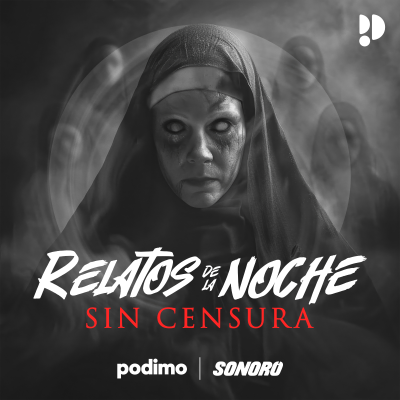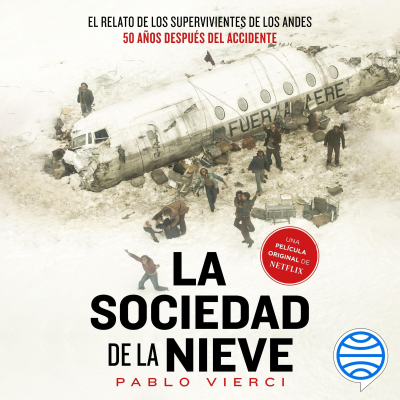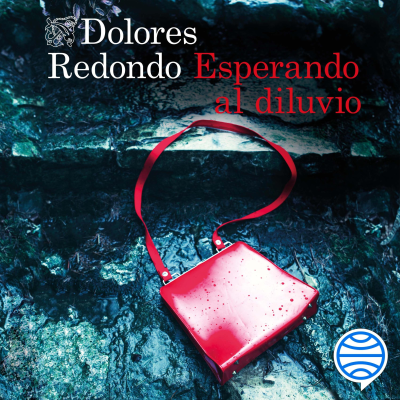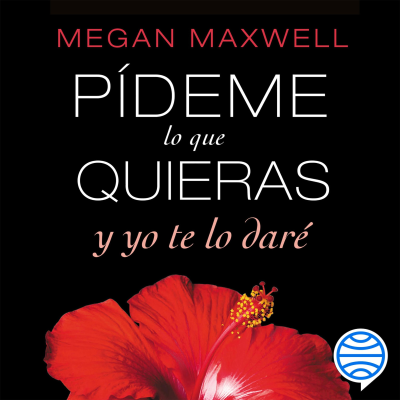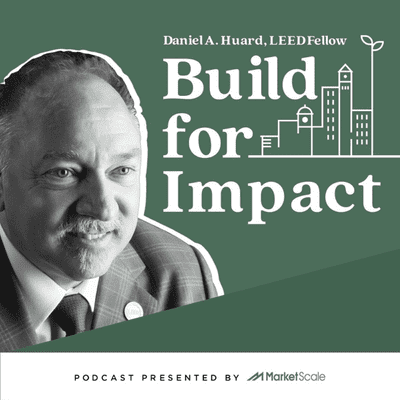
Build for Impact
English
Culture & leisure
Limited Offer
2 months for 19 kr.
Then 99 kr. / monthCancel anytime.
- 20 hours of audiobooks / month
- Podcasts only on Podimo
- All free podcasts
About Build for Impact
Sustainability, transparency, wellness and resiliency are the pillars of the green building world. Host Daniel Huard, the Godfather of Sustainability, collaborates with the experts around the world focusing on green design.
All episodes
19 episodesReintroducing Common Sense for Sustainability and Resiliency
In talking about the pillars of green building, it’s possible to look to the past and future. Ancient cities show signs of sustainability, resilience, and wellness. Many of these components are common sense, and their reintroduction is changing how the world builds. Talking about the pillars, host Daniel Huard welcomed architect, Blake Jackson. Jackson is the Sustainability Design Lead at Stantec. He’s also an adjunct professor at Boston College and Roger Williams University. Additionally, he’s also a LEED-WELL faculty member and an advocate and speaker on the subject. The conversation started with sustainability, with Jackson noting he wasn’t educated on it during his architecture studies. “I’m trying to remedy. Before, it was something architects didn’t think they controlled,” he added. LEED was the catalyst for reshaping the sustainability conversation. “We’re reintroducing common sense into building as modern practitioners,” Jackson said. With sustainability also comes the need for resiliency of projects. “We’re in the business of bandaging, handling things brick by brick, but it’s encouraging to see more cities taking it on. We’ve lost the ability to think at scale on resiliency in this country,” Jackson commented. They two also discussed transparency and its evolution. Manufacturers are now much clearer on information about supplies. Jackson also credits the fact that “the green community is open.” Thus, sharing ideas with colleagues helps the greater good. The wellness component was also forgotten in the 20th-century. “Our ancestors did this way back to the Romans that were using winds to understand ventilation. Now the wellness component is tangible in building, ergonomics, fresh air, natural light,” Jackson said.
How Resiliency Overlaps with a Commitment to Sustainability in Design
Built for Impact provides a new angle on the relationship between humans and the Earth—the spiritual one. Host Daniel Huard spoke with Tim Yearington, an indigenous educator and tribal leader. Yearington’s ancestral name is “Grey Thunderbird.” Yearington offered feedback on Huard’s four pillars: sustainability, resiliency, transparency, and wellbeing. On sustainability, Yearington noted it’s a human-made concept since the Earth sustained for some time without human intervention. “There’s plenty of evidence of what we’re doing collectively to the plant, and it’s not sustainable. Extracting resources to make money is a destructive force.” Shifting to resiliency, which overlaps with sustainability, Yearington shared, “Our ancestors were more resilient. Going back to nature will teach us what it means. What you want doesn’t make you resilient, what you need does.” Sustainability and resiliency both require transparency, which Yearington believes is just being honest as well as open-minded and -hearted. The last pillar is wellbeing, and all four share equal space in the same circle. “It’s all connected and related. While we can use the resources of the planet, we breached the code with take, take, take,” Yearington said. Everything that happens in the world by humans has an impact. Learning to live in harmony and appreciate the Earth could help achieve balance amongst the four pillars.
Reinforcing the Bottom Line with Sustainable Strategies
Environmental champion, Anthony Guerrero, is both a Board Chair for the International Living Future Institute as well as the Chief Real Estate and Sustainability Officer at Natural Resources Defense Council (NRDC)—an organization of more than three million members and online activists with the expertise of some 700 scientists, lawyers and policy advocates across the globe to ensure the rights of all people to the air, the water and the wild. Leading the development of sustainability strategies for NDRC’s core operations, Guerrero focuses on the triple bottom line—social equity, sustaining the environment and financial viability—putting in to practice the principles of the Living Building Challenge to revamp the internal operations of NRDC and to demonstrate transformation in Operations Management. Build for Impact, a Green Building podcast by MarketScale, is a platform that allows for collaboration with some of the best minds in the world who focus on green design and sustainability, then incorporating these ideas into building projects to help lessen their environmental impact, ensuring a cleaner future for the next generation. And on this episode of Build for Impact, Guerrero joins host Daniel A. Huard, LEED Fellow and the Godfather of Sustainability. They discuss the catalyst that peaked Guerrero’s interest in the environmental movement and a career that centers around building sustainability, projects that he has led to reduce our carbon footprint, the issues of climate versus social justice, the Living Building Challenge, implementing rigorous Materials Petal Certification to offset the adverse effects that building materials have on humans, other species, our planet and its resources, the industry’s responsibility, and more. Attaining, at the time, the highest-rated LEED Platinum V2 build-out for both their New York and DC offices, when NDRC began the process for their Chicago office, Guerrero was caught off guard by concerns from his own team. “Our staff—who are very immersed in these issues of toxins in our materials and in our everyday products—they would ask me about the materials we were bringing into our spaces, and I realized that the rigors that we were doing to adhere to the LEED-scorecard were not as rigorous as the expectations of our staff. So I kept looking for a better way to ensure that we didn’t have any of the toxins that we were advocating against in our DC material selection, in our process at all,” remarked Guerrero. “During our build-out in Chicago, Eileen Quigley (NDRC Sustainability Manager) brought up the Living Building Challenge Petal Certification for materials. We found that it was rigorous—far and above what we were doing before. We realized it was going to be extremely hard, but it paid off. We did that work and didn’t have a single concern from our staff. We had evolved to be actually more rigorous and more aggressive in our vetting of materials.” Listen To Previous Episodes of Build for Impact Right Here! [https://marketscale.com/industries/original-series/build-for-impact/]
How Transparency Can Lead to Sustainable Building
Sustainability is a topic that is becoming more and more a part of our daily conversations at home and in the workplace. Daniel Huard, Host, Build for Impact, spoke with Jeremy Sigmon who is an independent consultant working on sustainable and resilient buildings, infrastructure and cities, about some key topics trending in the sustainability space at the moment. Sigmon is an accomplished professional in green buildings, resilient cities, and the circular economy. A circular economy is an economic system that works towards eliminating waste and the continual use of resources. Signmon feels that transparency is paramount in being able to make a transition towards a circular economy happen. “The core tenet is about getting the right information into the right decision makers’ hands, so that more informed decisions can be made...But the transparency equation, you know could very much encompass things well beyond materials. Being able to actually translate information about whether it's environmental impact, or social impact, or potential for resilience and durability,” Sigmon said. He believes that all of these attributes ultimately create an opportunity for a decision maker to make a more informed decision about which material, product, or company is the right one to invest in. He thinks that one of the things that those thinking about transparency have always had to contend with, is knowing at what point there is too much information being shared and what information actually has value.
The Evolving Pillars of Green Building
The realm of green building has evolved dramatically in the past 20 years. While sustainability has been a term that dates back further, it wasn’t so long ago that green design wasn’t mainstream, more of an afterthought. To discuss this evolution and its impact on the four pillars of green building, host Daniel Huard welcomed Katie Weeks, a sustainable design expert. She currently serves as the Manager Director, Communications and Development at the Institute for Market Transformation (IMT). Huard met Weeks when she was the editor of Ecostructure Magazine, a publication of Hanley Wood. In her years at Hanley Wood, she was able to be a part of and start dialogues around green building. Her position at IMT is now more hands-on. So, what’s the evolution she’s seen? “In the past, when people spoke about sustainable design, it was standalone, a silo. Now it’s mainstream, and green design is just good design,” she remarked. Huard and Weeks then touched on the other pillars of green design, resiliency, transparency, and wellness. “Resiliency is about more than can a building survive a natural disaster. It’s about is the space flexible for a longer life span. Future-proofing a building is more than just the technology aspect. How will a building’s role evolve in supporting the community?” Wells said. Transparency in green building is also critical. Sharing information and knowledge benefits has a greater collective impact. IMT is working with local governments on building performance programs. “With building benchmarking data not publicly available in many jurisdictions, we can understand how that space is actually performing,” Weeks added. Finally, wellness is a top priority, and the pandemic has changed that discussion. “We’re having conversations with architects, designers, and engineers about what makes a healthy space. Not just for those using it but for all of the community,” Weeks noted. Listen To Previous Episodes of Build for Impact Right Here! [https://marketscale.com/industries/original-series/build-for-impact/]
Choose your subscription
Limited Offer
Premium
20 hours of audiobooks
Podcasts only on Podimo
All free podcasts
Cancel anytime
2 months for 19 kr.
Then 99 kr. / month
Premium Plus
Unlimited audiobooks
Podcasts only on Podimo
All free podcasts
Cancel anytime
Start 7 days free trial
Then 129 kr. / month
2 months for 19 kr. Then 99 kr. / month. Cancel anytime.






